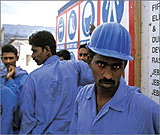 |
Migration to Gulf at record high |
NLast month, 2,500 workers rioted at the construction site of what will be the world’s largest building in Dubai, protesting against unpaid wages and miserable living conditions. The incident, widely covered in the international media as the grime behind Dubai’s new glitz, brought attention to Asian migrant workers in the Middle East.
Official statistics suggest that a good proportion of them are Indians. Just as the Gulf oil boom drew lakhs of Indian workers in the 1980s, a new boom—particularly in the UAE where some of the world’s biggest development projects are under way—appears to have triggered a spurt in blue-collar migration from India over the last two years.
Figures from the Protector of Emigrants’ Office show that migration of unskilled and semi-skilled workers has been steadily increasing since 2000, after a steep fall in the post-Gulf war, recession-ridden late 1990s. Last year, a record 5.49 lakh workers got an emigration clearance stamp on their passport, the highest in over two decades.
Indian workers are increasingly heading for UAE, Saudi Arabia and Kuwait, although Malaysia, also seeing a boom and recently streamlined migration procedures, is emerging as a big destination displacing Kuwait last year as the third most popular destination. Recruitment agents in Mumbai and Kerala confirm a rise in demand for manpower in the Gulf, especially in construction, oil and gas, petroleum and maintenance. “Welders, construction workers and mechanics are most in demand,” says Glenn D’Cruz, of International Overseas Services.
Experts say actual numbers are likely to be higher since official figures are at best indicative. For one, there is considerable illegal migration and secondly, while migration trends are extrapolated from emigration clearance statistics, such clearances are not required for several categories of workers including, for example, graduates. Recently, these categories were expanded—meaning many more people migrating for work have fallen out of the Protector of Emigrants’ radar. “This, combined with the Arabisation policies initiated in the 1990s make the trend more significant,” says migration expert S. Irrudyarajan.
More jobs, shortage of workers
Paradoxically, many agents say that while demand is rising, they are not able to find the manpower to meet it and have to reach into smaller towns to get workers. They attribute this to the construction and economic boom in India, which not only means more jobs but higher salaries.
“Gulf salaries are stagnant, making the difference smaller and less worth migrating for,” said D’Cruz. Adds Mohammed Ghanchi of manpower agency SG International, “In the 1990s, if we put an ad out for 100 jobs, we could get 200 applicants. Today, I get 60.
A construction labourer would get between Rs 7,000 to Rs 9,000 a month, a driver Rs 12,000 plus and a welder up to Rs 30,845, say agents.
Migration experts counter that Indian salaries for unskilled labour have not risen much—except in Kerala—and suggest the perceived shortage may be only for skilled workers, or due to people bypassing big agents..
|
|
|
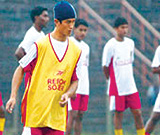
|
Here is a helping hand from the US
|
Indian football does not need help. It needs ‘serious help’. Last year the A.I.F.F. seemed serious about having foreigners of Indian origin (NRIs) take up citizenship and build a strong national team. The idea—urged by then coach Stephan Constantine—was fantastic, but then till date remains far from reality.
Thus, while Vikash Dhorasoo, Michael Chopra and Harpal Singh, to name a few, have given India some reason to cheer by donning the colours of the best clubs in Europe, a few in our Indian team would at least make us competitive before becoming a force to reckon with.
Having made his mark as a player in the US, Neel Bhattacharjee, a naturalised citizen of that country, has been the latest addition to the growing list of ‘experts who trade their skills abroad’.
Recently appointed as the goalkeeping coach of the U-21 US women’s team, Neel, already four years into coaching, is doing a job in a country that takes football seriously.
Now, Neel’s ability can surely be exploited, particularly when one realised that US enjoys Top-4 status in women’s football..
|
|
|
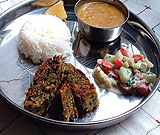
|
Knock, Knock. It’s Indian Comfort Food.
|
It’s a few minutes after 1 p.m. on a Friday, and Raj Desai is ready for lunch and waiting for a knock on his door. A man he knows as Kishan soon enters his office with a clear plastic container that holds his lunch: fish fry, rajma masala (curried kidney beans), yogurt, rotis and rice.
As executive director of a large non-profit organisation in Santa Clara, Mr. Desai barely has time to leave his office, but eating a good lunch is a high priority for him. Food from any old place, a cafeteria, a restaurant or takeout, Indian or otherwise - will not do.
So he relies on a company called Annadaata, which makes lunch and dinner boxes for clients in the Bay Area.
This lunchtime scene is being played out each weekday in the United States in metropolitan areas with large South Asian populations. They depend on delivery workers to bring them the home-cooked foods of their upbringing, often prepared by cooks working from home.
Having such a lunch is a way of life in Mumbai, India, where dabbawallas or tiffin-wallas (men who carry tiffins, the containers that hold the food) use an elaborate, 120-year-old system to transport lunches to workers at mills, shops and offices.
In Mumbai, formerly Bombay, the tiffin, or lunch, is prepared by the wife, mother or servant of the intended. In the United States, because of little time (and a lack of a domestic staff), many of these lunches are prepared by outsiders, but the underlying principle is the same.
With the spread of these services, Punjabis can have their saag paneer and meat curries; Gujaratis can have their dal, bhat (rice), shak (vegetables) and rotis (flatbreads); and south Indians their rasam (tomato-based curry).
|
|
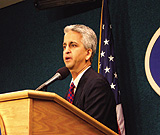 |
Gulati takes charge of US soccer
|
Arnold Schwarzenegger, from Austria, governs California. And as of this week, Sunil Gulati, born in India, presides over the United States Soccer Federation.
The comparisons are few. Schwarzenegger is big, and came through Hollywood. Gulati is physically no match for him, and teaches economics at Columbia University, New York.
Yet, as the US soccer squad prepares to play Germany in Dortmund as a warm-up to the World Cup in June, the new soccer president represents the all-American dream of rising from grass roots to the pinnacle of his game. Gulati sees this as the start of a push for greater recognition of diversity in US soccer, but from the outside it looks a fantastic journey from early childhood in Allahabad on the Ganges to the leading role in his chosen sport in his adopted land.
To know Gulati is to know his strength of quiet perseverance and applied logic. There are not many men who better represent the catch phrase of adopted by the international sporting authority FIFA: “For the Good of the Game.”
When he was five, his parents emigrated to Connecticut. When he was seven he began his fixation with soccer. When he was 16, he and a friend, Nick Mongillo, formed their own team.
But while soccer struggles for air time dominated by football, baseball, basketball and ice hockey, Gulati seemed to be involved at every level of its growth spurt over the past two decades. Paul Kennedy of Soccer America, sums up: “Over the last two decades, US soccer has been lucky with its presidents: Werner Fricker, a former carpenter who built the foundation, Alan Rothenberg, the Los Angeles attorney who did the deals, Bob Contiguglia, the Denver kidney specialist who mended the divisions, and now U.S. Soccer has picked Gulati, the economist who understands the limitations of
money.”
|
|
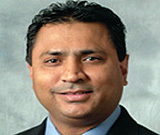
|
Out of differences come debate and compromise: Ash Patel
|
Ash Patel, the new secretary of the Asian American Hotel Owners Association (AAHOA), is known for cutting to the chase on any issue, but with a view to negotiating a compromise rather than encouraging confrontation.
“We have had a banner year,” he told News India Times. “We bridged a lot of relationships,” he said in the context of differences with sponsors and vendors last year.
“Over the last two years, we as a teenage organization, had a lot of internal turmoil with the differences in the Board. But the differences were all positive,” he quickly affirms. “Out of differences, come debate, negotiations, and compromise.” Known by the dictum “business is business” Ash is nevertheless ultimately, a negotiator.
“Consensus is not always good. I actually like debate and working out differences,” he says. The hoteliers organisation, he says, is breaking new ground with revenue sharing, record dollars spent on educational events.
|
|
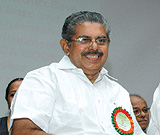 |
South Indian states keen to set up NRI varsity: Ravi |
Minister for Overseas Indian Affairs Vayalar Ravi Saturday said some south Indian states have expressed their desire to set up a university for non-resident Indians (NRIs) and persons of Indian origin (PIO).
“Sorry, I can’t name which are the states but Kerala so far has not expressed its desire to establish the university. It would be a deemed university and 50 percent of the seats would be reserved for the children of NRIs and PIO and the remaining 50 percent for Indian residents,” said Ravi while interacting to reporters here.
He also elaborated that the Kerala government has to set aside the required land and the centre of learning would be set up by overseas Indian trusts or societies with credible standing and experience in the field of education under the overall supervision of the Ministry of Overseas Indian Affairs.
“Already a few Indians settled in the US have expressed their desire, but it is clear to us that it can be set up by only reputed educational institutions,” said Ravi.
The union cabinet recently cleared a proposal to set up the university in a Special Economic Zone (SEZ) under the University Grants Commission Act.
|
|
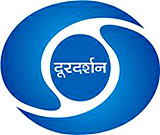 |
DD to launch two channels in UK |
After years of uncertainty, India’s state-owned television network Doordarshan will begin broadcasting two free-to-air channels here with the idea of bringing “the essence of India to Great Britain” from April 16.
The Rayat Group, the private company that will distribute here, the two channels, DD India and DD News, will start broadcasting 24 hours a day from April 16. The content will be mostly in Hindi.
The launch of the channels is expected to provide a base for further expansion into Europe. Doordarshan will be the latest channel targeting the Asian/Indian diaspora in Britain. The current channels bouquet includes STAR TV, Zee, Sony, NDTV, and others produced and distributed from within Britain, such as MATV and Raj TV.
DD India is expected to offer a mixture of content including music, children’s programmes, sports, travel, documentaries and current affairs, while DD News will compete with established names such as NDTV, Star News and Zee News.
“Our primary objective is to provide our viewers with high quality programmes which entertain, educate and inform. This will be a unique medium for British Asians,” Khalid Mahmood, CEO of Rayat Group, told the AIM Magazine.
Added Inari Sharma, marketing manager for Rayat TV: “Doordarshan will provide the most innovative and rich content and bring the essence of India to Great Britain. With the largest library of subcontinental programming in the world, we will be able to offer a unique blend of content that until now has not been available to viewers in the UK.”
|
|